B2B Marketing Analytics: Find Every Fast Path To Profit
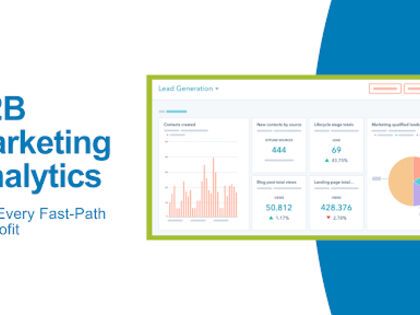
- Use a combination of five or more analytics tools to significantly enhance marketing performance.
- Set up analytics platforms like Google Analytics and Google Search Console to gather essential data insights.
- Focus on key metrics that align with business goals to simplify data analysis and optimize decision-making.
- Continuously test and optimize marketing components using A/B testing to maximize campaign effectiveness.
- Partner with analytics experts to streamline data analysis and enhance business decision-making processes.
Never before have marketing teams enjoyed access to so much data, and yet, according to a recent Gartner survey, analytics influenced only 53% of marketing decisions last year. Imagine the missed opportunities, the untapped ROI, and insights falling through the cracks.
Analytics is the exercise of transforming raw data into actionable insights – a process that can appear complex without knowledge or experience. Ask the countless marketing teams still struggling to understand and put data to work where it matters most.
As a result, our goal is to cut through the complexity, helping:
- Define what B2B marketing analytics is and why it’s essential to your business.
- Outline a process for implementing analytics within your organization.
- Explain what tools and programs exist to help you gather and leverage data more effectively.
Note: If you are looking for someone with experience tracking, reporting, and continuously finding avenues of profit through data, our marketing industry veterans can do that for you.
What is B2B Marketing Analytics?
As we mentioned above, B2B marketing analytics is the process of transforming raw data into actionable insights. While it’s easy to become overwhelmed, the more data sources you can access and compare, the better the results that follow. One study shows that marketers wielding five or more tools in their analytics stack are 39% more likely to see a leap in their marketing program’s performance. This isn’t mere coincidence; it’s the result of transforming unorganized data into patterns in user behavior that can be used to optimize performance and usability.
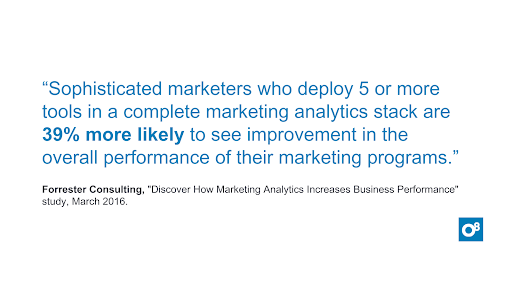
Are you curious how many potential customers are visiting your website? Analytics helps you sift through the traffic, identify the sources, and present this information in an easy-to-understand format. Simple as that. The phrase B2B marketing analytics may evoke complexity, but it’s also quite simple. Let’s break down the analytics concept into its three components:
- Datasets: Consider datasets as raw materials. Datasets taken from your website, social media profiles, email marketing platform, and other sources can be used as building blocks to develop strategies for each channel.
- Lenses: These are your filters, your tools to zoom in on the specifics, be it current customers, new prospects, or the channels driving traffic to your site.
- Dashboards: Visual aids such as charts, metrics, and tables that translate the filtered data into actionable insights.
Understanding how to use datasets, lenses, and dashboards is the first step toward realizing the importance of B2B marketing analytics to your business.
Why is B2B Marketing Analytics Important?
Especially with time and money on the line, relying on data-backed facts over assumptions always prevails. Using intuition and your organization’s conventional wisdom to make decisions is rarely a good idea. Intuition can fail you regardless of the environment, and conventional wisdom can become outdated and irrelevant over time.
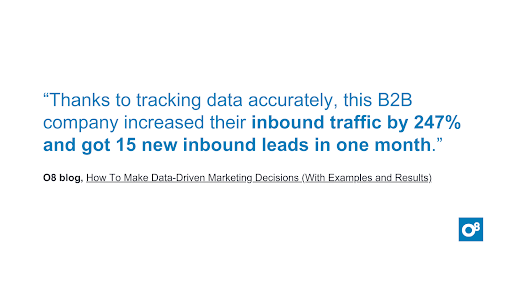
Luckily, It doesn’t have to be this way. More tools and platforms are now widely available and easily accessible than ever. For leaders in the data-driven world, tech-enabled B2B marketing analytics platforms and the insights that flow are helping transcend the mundane for ordinary teams and companies to become dynamic, high-growth organizations. As a result, data-driven organizations often see and realize the value of these enhancements in a few key areas:
- Uncover the Secrets of Campaign Performance: What’s driving your website traffic? What ignites engagement and converts prospects into loyal customers? Analytics puts you in the driver’s seat, illuminating the path to success.
- Maximize Your Return on Investment: With precise insights, you can determine the ROI of various campaigns to inform decisions on what to scale, what to tweak, and what to stop altogether. The right intel empowers you to multiply ROI, making every dollar in your budget count.
- Craft a Tailored Customer Experience: Have you ever wondered where your prospects enter your funnel or why they hesitate at a particular stage? Analytics offers a magnifying glass, revealing the intimate dynamics of your customer interactions. Understand their needs, desires, and roadblocks, and shape an experience that feels personal and resonant.
How to Measure B2B Marketing Analytics: Step By Step
At O8, we’ve developed a simple yet effective four-step process that guides clients through onboarding and executing their analytics programs. Follow these four steps as you get started with analytics, or contact us for assistance with effective B2B marketing analytics.
1. Set Up Your Analytics Platforms
You don't have to build your team's analytics from scratch. A series of commonly used platforms are relatively simple to set up. (Below, we'll explore popular platforms regularly used for B2B marketing analytics.)
Start by identifying what analytics platforms are available to you. For example, most marketing teams have access to web analytics, email marketing analytics, pay-per-click advertising analytics, plus others.
Next, identify the analytics platforms that fit your needs and goals aligned to key metrics. Extracting organic search data from free tools like Google Analytics and Google Search Console is always a good first step.

One of our B2B client's Google Analytics 4 dashboards shows the number of prospects that lead generation-focused pages bring each month.
A premium search engine platform like Semrush can provide more advanced data and web analytics to better inform search engine optimization and marketing decisions. A CMS platform like HubSpot can provide a more refined picture of your pipeline and customer interactions if you need to focus more on lead generation and nurturing. Programs like Sprout Social work to produce the same data and metrics on social media, helping to streamline and refine content generation.
2. Decide What Numbers Matter
Analytics platforms provide a wealth of data. Some data might be extremely useful and relevant when matched against your goals and marketing efforts, while other metrics are less important. Here, an effort to filter out the noise helps streamline what matters most. For example:
- Web analytics platforms indicate the channels driving traffic, the web pages capturing attention, and the common paths visitors take through your site.
- Email marketing analytics provide the open rates, click-through rates, and unsubscribe rates related to different messages and workflows.
- Social media metrics allow you to track how prospects and customers interact with your brand or services online.
- Pay-per-click ad analytics deliver data on what campaigns deliver the highest return on investment and which don't.
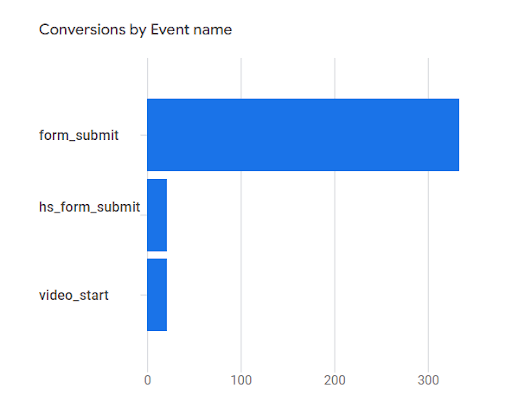
One of our B2B clients' Google Analytics 4 dashboards shows the number of form submissions they have received in the last 90 days. We report on leads, not on website visitors.
Determining the most important numbers to your business is a key part of the analytics process. In the vast universe of available data, it's worth reflecting on what unique data points impact your business and its bottom line. Overwise, you can easily get bogged down and lost in trivial numbers that don't lead to better and more informed decisions.
3. Identify What’s Working (And What’s Not)
Once you determine the most critical numbers for your business, it’s time to identify what’s working and what’s not across your marketing efforts.
For example, low bounce and high goal completion rates are predictive of your website performance. Conversely, low open and click rates with high unsubscribe rates are negative indicators of your email performance.
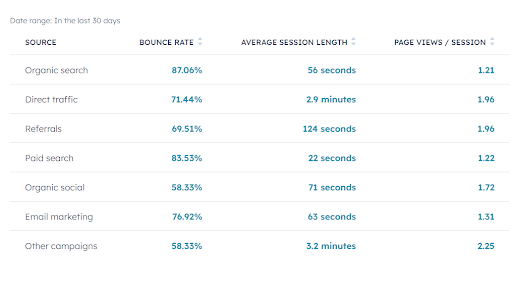
HubSpot’s bounce rate report
Advanced analytics platforms like HubSpot or Salesforce (Pardot) can also help you identify the marketing campaigns and channels driving the most closed revenue and the underperforming campaigns and channels.
4. Optimize Your Campaigns
The highest-performing marketing teams don’t just set and forget their campaigns. They test different messages, creative assets, various cadences, and target audiences. They continuously test and optimize based on performance over certain periods in continuous feedback loops.
Look at your best-performing blog posts and web pages and use them as templates for future content. Analyze the subject lines and CTAs that drive the most opens and clicks in your emails, and use them as inspiration for creating future messages. Repeat the testing and optimization processes repeatedly to reach a campaign’s peak potential and maximize revenue.
Without the right analytics, this transformation is not just challenging; it becomes virtually impossible. For example, A/B testing uses two different headlines, subject lines, CTAs, or other components to see which one performs best.
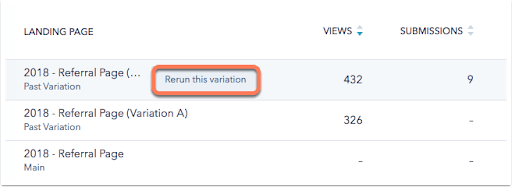
HubSpot’s A/B test report
A/B tests can help you optimize messages, landing pages, and other marketing materials — but A/B testing at scale requires tools. Many of the platforms described below that allow for B2B marketing analytics also allow for A/B testing.
Breaking Down B2B Marketing Analytics Tools
Today’s B2B marketing analytics tools are highly accessible. You’ve likely used or are familiar with many of the common tools in the marketing universe. Here’s a look at the tools we regularly use at O8.
Google Analytics
Google Analytics is the perfect starting point for determining how and what to measure related to your marketing performance. It is a powerful, free tool that can be the foundation for your B2B data analytics collection. An O8 B2B service client recently increased inbound traffic by 247% and generated 15 new inbound leads in a month after embracing a data-first approach that included Google Analytics’ marketing data.
With Google Analytics, your team can:
- Follow online traffic sources right to your virtual doorstep. See where visitors come from and where they arrive.
- Track how your visitors interact with your site and navigate from page to page, including what pages have the highest bounce rates. These analytics let you peel back user interaction layers to reveal what engages your audience.
- Master the conversion game by creating goals and monitoring the content that drives your users to take desired actions (including form completions, purchases, etc.).
This platform provides a peek into how your website performs over time. Dips in performance can then become opportunities for ongoing testing and optimization.
Google Data Studio (Now Looker Studio)
In a world full of numbers and statistics, Google Data Studio, now reimagined as Looker Studio, empowers marketing teams to process, sift through, and analyze so that numbers and statistics transform into actionable insights.
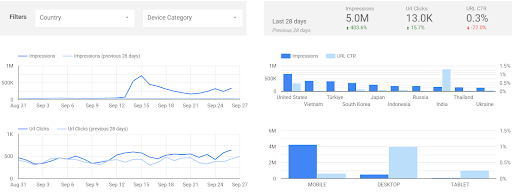
One of our B2C clients' Looker Studio dashboards shows information from Google's Search Console
With Looker Studio, you wield the power to:
- Harness various data sources, from Google Analytics to Google Ads to social media accounts, weaving them into a coherent narrative. Most sources of B2B marketing analytics exist in disparate dashboards — Looker Studio allows you to access analytics from different sources in a single dashboard.
- Visualize your source data with vibrant charts and insightful tables, turning lifeless digits into lively insights. Looker Studio’s data visualization capabilities are particularly helpful when presenting to executives on marketing performance. Company leaders typically don’t have time to look at complex dashboards and spreadsheets, making effective data visualization the perfect way to share key findings.
- Craft reports that emphasize your business's most important numbers and speak to your entire marketing and sales teams.
Looker Studio makes creating and presenting reports an intuitive, streamlined experience. Gone are the days of sifting through raw data or trying to unite data from disparate sources into a single view. Looker Studio provides a unified view across all your team’s B2B marketing analytics to simplify the process.
Google Tag Manager
Google Tag Manager is designed to streamline the often cumbersome process of managing tags on your website. Tags are snippets of code that allow for data collection across your web pages, landing pages, and blog posts. What once required digging into the code can now be handled through Google Tag Manager’s web-based interface, making it a go-to tool for marketers and website managers.
And don’t worry about the price tag; it’s entirely free.
With Google Tag Manager, you can:
- Add and Update Tags Easily: Implement tags for conversion tracking, site analytics, and more without touching a line of code.
- Enjoy Error-Free Management: Built-in error checking and rapid tag loading ensure your tags work smoothly and efficiently.
- Deploy Diverse Tags: Not just limited to Google Tags, you can also manage third-party tags, offering a central hub for all your tagging needs.
By taking the complexities of coding out of the equation, Google Tag Manager lets you focus on what’s essential: using tags to gather insights and drive your marketing strategy forward.
Google Search Console
Google Search Console offers an essential perspective on your website’s performance in search results. This free tool is indispensable if you aim to rank higher for key phrases searched via Google.

One of our e-commerce clients' Google Search Console dashboard shows our clients' daily traffic.
Google Search Console allows you to:
- Monitor how your webpages and blog posts perform in Google search results. You can see how many impressions and clicks your content gets when served on Google’s search results pages, providing insight into what Google and its users value on your website.
- Stay informed with automatic notifications if Google detects any issues on your site. These alerts enable prompt responses to problems that might affect your ranking.
- Submit sitemaps and individual URLs to control what Google crawls. This puts you in the driver’s seat, allowing you to efficiently guide Google’s search bots through your site.
By letting you monitor your site’s performance, identify issues, and take actionable steps, Google Search Console becomes essential to maintaining and enhancing your website’s presence in search results.
HubSpot
In the competitive world of digital marketing, HubSpot stands out as one of the best and most comprehensive Customer Relationship Management (CRM) systems that caters specifically to your marketing needs. This versatile platform helps you manage customer relationships while providing robust analytics to optimize campaigns and targeting.
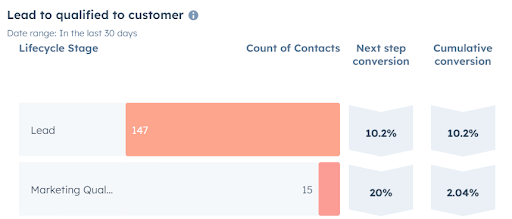
One of our clients' HubSpot CRM analytics dashboards shows the amount of leads and marketing-qualified leads one of our clients has generated in the last 30 days.
With HubSpot, you can:
- Enjoy a panoramic view of your marketing landscape, from your website’s essential metrics to detailed reports for every marketing channel.
- Connect marketing interactions to closed revenue. HubSpot’s multi-touch attribution model helps you understand what drives conversions.
- Visualize your campaign's real-time data through customizable B2B marketing analytics dashboards, and create reports that monitor CRO marketing performance while illuminating your overall marketing impact. Build dashboards that emphasize the numbers that matter most to your business.
What sets HubSpot apart is its flexibility. Loom, Teamwork, and Zapier are among the companies that lean on HubSpot for B2B marketing analytics. Zapier used HubSpot’s analytics to deliver targeted content at the perfect time to drive purchases — leading to a 50% increase in demo uptake and a 2x conversion rate.
How B2B Marketing Analytics Experts Can Take You Further
Analytics are a must-have for all marketing teams, large and small. Finding time to implement and leverage data analytics effectively is vital regardless of your goals or responsibilities. That said, the deeper you get into it, the more effort is required to gather, sort, and make sense of the data to inform business decisions.
While the formula for analytic success is straightforward, leaning on a partner agency with the expertise and track record of success can take your marketing to new heights. Not only to advise and implement the right platform on your behalf but to translate the data into insights that matter to your business, saving you hours of time and effort sifting through information to get to the value.
At O8, we are experts with Google Analytics, HubSpot, and the other tools required to monitor campaign performance and make important decisions around optimization effectively. Partnering with O8 grants you an expert B2B marketing analytics partner who can help you focus on the numbers that impact progress toward your company's goals. Contact us today to take the first step toward effectively using B2B marketing analytics.
Semrush
Semrush is a versatile platform that enables you to analyze your website’s performance in search results and gain a bird’s-eye view of your competitors’ strategies. It’s a tool that gives you the intelligence to outperform and outsmart the competition.
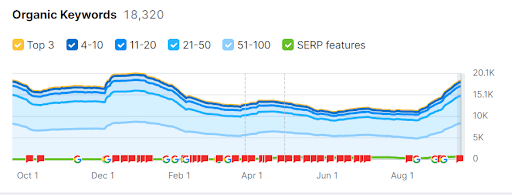
Semrush's analysis of the amount of keywords that O8 ranks for.
With Semrush, you can:
- Identify keywords that drive traffic to your competitor’s sites and find opportunities to rank higher. Semrush’s keyword tools help you uncover the best keywords for your unique business needs.
- Assess the SEO health of your website with detailed audits that pinpoint areas of improvement. Whether it’s content optimization or technical issues, Semrush guides you in making necessary adjustments.
- Discover potential backlink sources to boost your site’s credibility and rank. Semrush’s backlink analytics make finding and pursuing valuable linking opportunities easy.
Semrush is a strategic guide that helps you craft a winning SEO strategy. It empowers you to improve online visibility, spy on competitors, and unearth invaluable insights that drive growth. Again, the proof is in the pudding. Take Universal Health Services using Semrush data to enhance its digital marketing performance and another SEO agency using Semrush data to boost a client’s mobile organic traffic by 460%.







